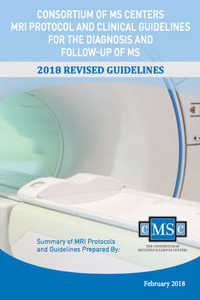CMSC’s Proposed 2018 Revised MRI Guidelines
IN THIS ARTICLE:
CMSC’s Proposed 2018 Revised MRI Guidelines
MRI Funding Assistance Available
The Value, Development, and Future of Imaging Technology in MS: An Interview with Dr. Rohit Bakshi
In February 2018, the Consortium of MS Centers (CMSC) published a booklet, 2018 Revised Guidelines of the Consortium of MS Centers MRI Protocol for the Diagnosis and Follow-up of MS. This guide provides the recommended frequency and types of MRI to be performed depending on each patient’s specific situation. These recommendations were created by an international group of neurologists, radiologists, and imaging scientists with an expertise in MS, representing some of the most influential and respected neurological and radiological groups in North America and Europe.
To follow is a simplified listing of some of their general recommendations:
For individuals with clinically isolated syndrome (CIS) or suspected MS, but who have not yet been diagnosed, a brain MRI with gadolinium should be performed at baseline. A follow-up brain MRI with gadolinium should be performed six to 12 months later for individuals with “high risk” CIS (those with two or more lesions on the first MRI) or 12 to 24 months later for “low risk” CIS (those who had normal findings on their first MRI).
 For individuals who have been diagnosed with MS, a brain MRI is recommended at the following times with gadolinium-based contrast advised in most instances*:
For individuals who have been diagnosed with MS, a brain MRI is recommended at the following times with gadolinium-based contrast advised in most instances*:
- When no recent MRI imaging is available
- Following a pregnancy to establish a new baseline
- Before beginning or changing a disease-modifying therapy (DMT) and approximately six to 12 months later to establish a new baseline
- Every one to two years to assess sub-clinical activity (with inflammation occurring in the brain but without any outward symptoms) and every two to three years for individuals with stable disease
- With worsening symptoms or when the diagnosis needs to be reassessed
A spinal cord MRI is recommended for individuals who show symptoms that may be related to the spinal cord, such as myelitis or progressive myelopathy. An older age at MS onset is another consideration for a spinal cord MRI. In some instances, a spinal cord MRI may be used to help with establishing disease-activity dissemination in space and time, providing more support to an MS diagnosis.
When using a brain MRI for surveillance of progressive multifocal leukoencephalopathy (PML) for individuals taking Tysabri® (natalizumab), the following timeframes apply:
- For individuals who are serum JC virus (JCV) antibody negative, a brain MRI is recommended at least every 12 months
- For individuals who are serum JC virus (JCV) antibody positive and have been on Tysabri for more than 18 months, a brain MRI is recommended every three months if high index and every six months if low index
The CMSC included this additional note: “Gadolinium-based contrast agents do accumulate in the brain and, to a much lesser degree with macrocyclic agents [certain gadolinium preparations]. While there is no known CNS toxicity, these agents should be used judiciously, recognizing that gadolinium continues to play an invaluable role in specific circumstances related to the diagnosis and follow-up of individuals with MS.”
Professionals should consult the CMSC’s booklet for specific protocol recommendations. This guide may be downloaded at www.mscare.org/mri.
*The CMSC states that the use of gadolinium-based contrast agents is helpful but not essential for detecting subclinical disease activity. This is because new T2 lesions can be identified on well-performed standard MRIs. The exception is when a large T2 lesion burden obscures new T2 lesion activity.
